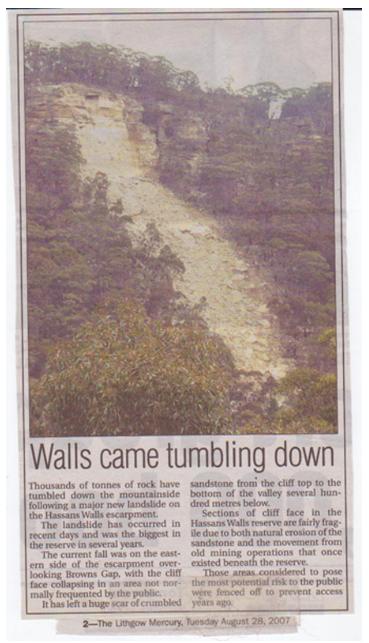Coalpac plundering Blue Mountains values
Saturday, May 14th, 2011In the north-western area of the Blue Mountains region of New South Wales (eastern Australia) lies the ancient Gardens of Stone. The area is so named because of its spectacular and rare sandstone rock formations known as ‘pagodas’ (large tapered, stepped or laminated sandstone formations) along with the abundance of native flora and fauna that thrive there.
Yet since November 2009, part of this beautiful pagoda country (some 1088 hectares of the Ben Bullen State Forest) with its important wildlife habitat, has come under threat of destruction from proposed open cut coal mining.
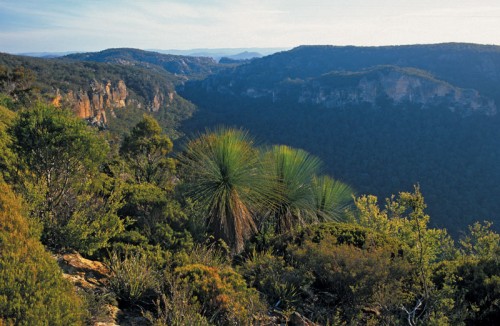 Johnson’s Grass Trees on Genowlan Mountain
© Photo by Jaime Plaza van Roon
(click photo to enlarge)
Johnson’s Grass Trees on Genowlan Mountain
© Photo by Jaime Plaza van Roon
(click photo to enlarge)
.
Gardens of Stone National Park
.
In 1994, a Gardens of Stone National Park was created covering 15,000 hectares and joining Wollemi National Park on the northern part of Newnes Plateau. Other large landscape features include the outstanding mesas of Donkey Mountain in the Wolgan Valley and Pantoneys Crown in the Capertee Valley. Pantoneys Crown was previously protected in a much smaller nature reserve, and is the centrepiece of the commanding view of the valley from Pearsons Lookout on the Castlereagh Highway.
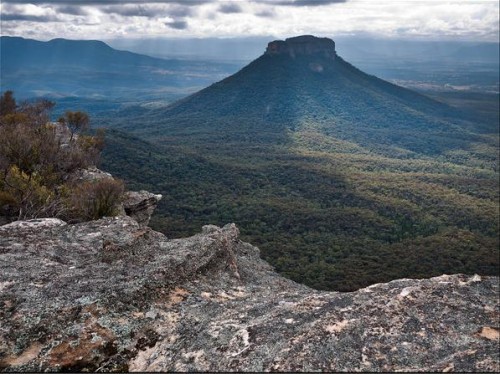 Pantoneys Crown, Gardens of Stone National Park, NSW
© Photo by David Braddon-Mitchell
[Source: ^http://dbm305.smugmug.com/Other/Pantoneys-Crown/13102823_B2fHx#950356269_VhEUF]
(click photo to enlarge)
Pantoneys Crown, Gardens of Stone National Park, NSW
© Photo by David Braddon-Mitchell
[Source: ^http://dbm305.smugmug.com/Other/Pantoneys-Crown/13102823_B2fHx#950356269_VhEUF]
(click photo to enlarge)
.
Gardens of Stone Proposed Stage 2
‘But Gardens of Stone is an unfinished park. Environment groups, including Blue Mountains Conservation Society, have advanced a plan to protect much more of this unique landscape, by extending the park and creating a new state conservation area over adjacent plateaus and escarpments which are presently state forest and Crown land. The overall proposal is known as Gardens of Stone Stage 2, situated just north of the town of Lithgow. (The state conservation area classification allows underground coal-mining to continue.)
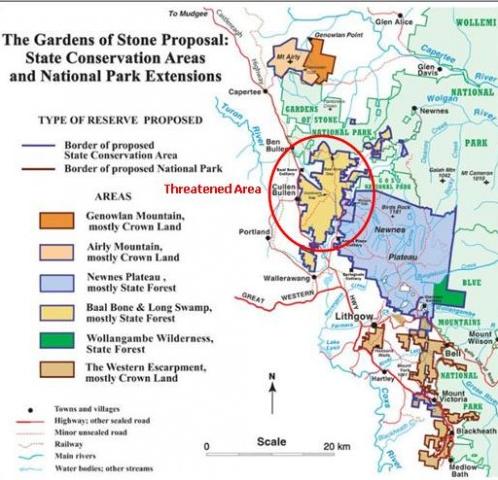 [Source: ^http://www.bluemountains.org.au/gos2.shtml]
[Source: ^http://www.bluemountains.org.au/gos2.shtml]
‘These unprotected areas are just as valuable as the existing park, and are rich in special environments such as pagodas and canyons, nationally endangered high altitude shrub swamps and an unusual heathland on Genowlan Mountain. Rare and threatened species include the beautiful yellow Pagoda Daisy, Deane’s Boronia, Blue Mountains Water Skink, Wolgan Snow Gum, Giant Dragonfly, Regent Honeyeater, Genowlan Pea and Beautiful Firetail. In the western parts of the area the moist mountain vegetation begins to give way to drier inland communities, including grassy box woodlands, one of the most diminished and threatened environments in Australia.
‘The Gardens of Stone Stage 2 provides one of the most beautiful displays of sandstone geodiversity in Australia, comprising dramatically coloured sandstone escarpments and promontories, narrow canyons, cave overhangs, swamps and the complex arrays of rock pinnacles known as pagodas. The area has one of the Blue Mountains’ areas of highest plant diversity including ancient windswept montane heathlands, nationally endangered upland swamps, a unique species of snowgum (E. gregsoniana) and other high plateau woodlands representing the highest development of native vegetation on Sydney Basin sedimentary rocks, poorly conserved grassy white box woodlands on slopes below the sandstone, fascinating oil shale mining ruins on spectacular Airly Mesa, and outstanding Aboriginal cultural sites on and around Newnes Plateau.
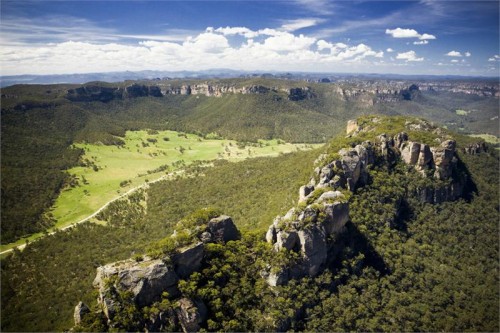 Gardens of Stone
© Photo by Hamilton Lund, Tourism NSW
Blue Mountains – Visit NSW, ^http://www.visitnsw.com/destinations/blue-mountains (click photo to enlarge)
Gardens of Stone
© Photo by Hamilton Lund, Tourism NSW
Blue Mountains – Visit NSW, ^http://www.visitnsw.com/destinations/blue-mountains (click photo to enlarge)
.
The area embraces the last unprotected part of the 1934 Greater Blue Mountains National Park proposal compiled by Myles Dunphy for the National Parks and Primitive Areas Council. It also includes the Blue Mountains Western Escarpment lands from Blackheath to Lithgow. The Gardens of Stone Stage 2 proposal advanced by The Colong Foundation for Wilderness, the Blue Mountains Conservation Society and the Colo Committee is to include all of the remaining parts of Newnes Plateau and surrounding sandstone uplands – an area of 40,000 hectares. It would protect the most spectacular pagoda landscapes in Australia.
Associated with these pagoda landforms are found large caves, mazes, ancient montane heathlands, endangered upland swamps, snowgums, grassy woodlands and moist gullies that contain tree ferns, stands of old growth forest and rainforest, and, in some places, slot canyons.
Reservation of Stage Two would also secure the outstanding ochre coloured cliffs of the Blue Mountains’ Western Escarpment and the rare plant communities that lie above them. Reservation of the remaining unprotected parts of the Gardens of Stone as a State Conservation Area is urgently required to rein in ongoing and accelerating environmental degradation.
[Sources: Gardens of Stone National Park, http://www.worldheritage.org.au/resources/national-parks/gardens-of-stone-national-park/ and Blue Mountains Conservation Society, http://www.bluemountains.org.au/gos2.shtml]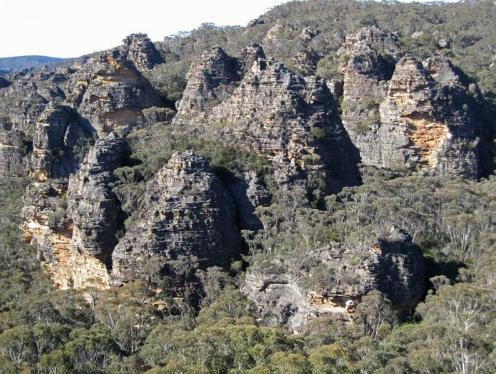 Pagodas of the Gardens of Stone (still outside the National Park)
Pagodas of the Gardens of Stone (still outside the National Park)© Photo by Andrew Valja [Source: Blue Mountains Conservation Society, http://www.bluemountains.org.au/gos2.shtml] (click photo to enlarge)
.
.
.
Threats from Coalpac Pty Ltd
.
CoalPac is a private Queensland coal mining company headquartered in Pullenvale in outer eastern Brisbane. In 1989, CoalPac took over coal mining operations outside the town of Lithgow in New South Wales, at the Cullen Valley Open Cut Mine and the Invincible Open Cut Mine. The Mines currently operate at 2 mtpa and Coalpac has plans for significant expansion of coal mines in the Gardens of Stone area.
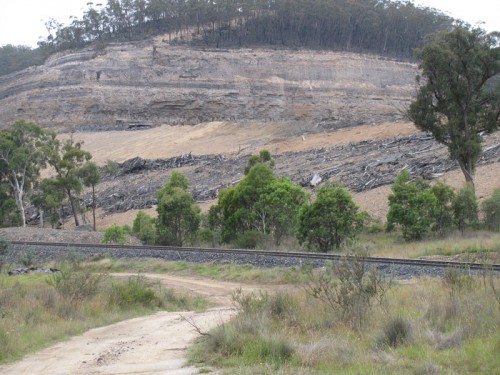 Coalpac’s CullenValley Mine
[Source: Lithgow Environment Group, Inc.]
(click photo to enlarge)
Coalpac’s CullenValley Mine
[Source: Lithgow Environment Group, Inc.]
(click photo to enlarge)
.
‘Coalpac is seeking approval for the consolidation and expansion of the existing Cullen Valley Mine and Invincible Colliery operations to produce up to a total of 3.5 million tonnes per annum.’ [Source: http://cetresources.com/about-us]This proposed extension of its open-cut and highwall mining will intrude into a large area of the publicly-owned Ben Bullen State Forest (BBSF), NSW. The extension area is equivalent of 2,176 football fields of predominantly old growth forest will be clear-felled and excavated if this goes ahead. The pagoda’s features and stability may be threatened by collapse.
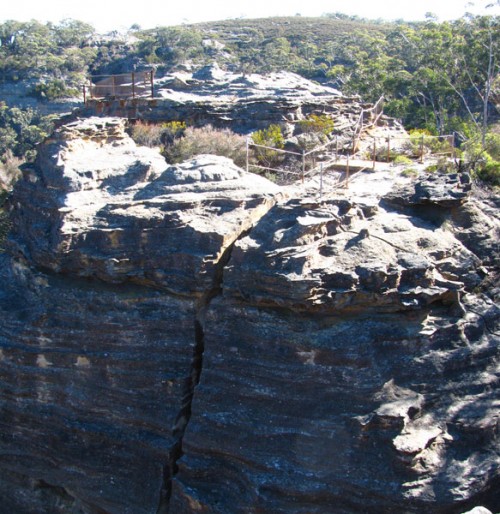 Cracked Hassans Walls, Lithgow ~ caused by nearby mining
[Source: Lithgow Environment Group, Inc.]
Cracked Hassans Walls, Lithgow ~ caused by nearby mining
[Source: Lithgow Environment Group, Inc.]
.
“The NSW National Parks and Wildlife Service (now within the Office of Environment and Heritage) has acknowledged its wish to add BBSF to the conservation reserve system as a matter of priority” says Lachlan Garland, President of the Blue Mountains Conservation Society.
“Allowing this operation would mean the equivalent of 2,176 football fields of predominantly old growth forest of the BBSF being clear-felled and excavated.
“This forest is a publicly-owned area of conservation and recreational importance. The community expects state forests to be protected from destruction in perpetuity.
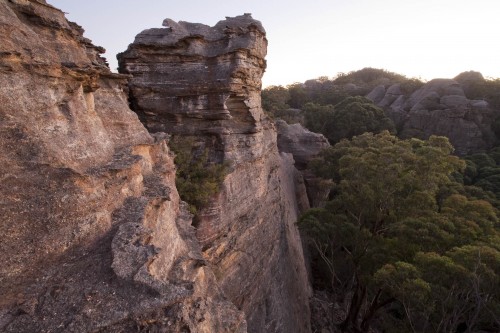 ‘Baal Bone Creek’ area at risk
©Photo by Ian Brown.
‘Baal Bone and Long Swamp (7,800 hectares) comprise massed pagoda ‘villages’ above the Long Swamp, a diverse swampy plain. They collectively form an evocative landscape of broken stone, reminiscent of Cambodia’s forest of State Forest temples, while nearby indigenous cave art honours this landscape.’
(click to enlarge, then click again to enlarge further)
‘Baal Bone Creek’ area at risk
©Photo by Ian Brown.
‘Baal Bone and Long Swamp (7,800 hectares) comprise massed pagoda ‘villages’ above the Long Swamp, a diverse swampy plain. They collectively form an evocative landscape of broken stone, reminiscent of Cambodia’s forest of State Forest temples, while nearby indigenous cave art honours this landscape.’
(click to enlarge, then click again to enlarge further)
.
“Habitats for the Regent Honeyeater, Tiger Quoll and Powerful Owl and at least 32 threatened native animals, 5 of which are listed under the EPBC Act, will be completely removed.
“Our iconic Lyrebirds also use the sides of pagodas to nest and raise their young. Mining will completely remove the protective pathways for adult birds foraging between nesting sites and will destroy their food habitats within the more fertile valley floors.
“The effective privatisation and liquidation of a large part of the forest is an outrageous precedent that should not be set; it is a direct challenge to the state’s efforts to reduce deforestation.
“The Blue Mountains Conservation Society seeks to work with the Minister for the Environment and Heritage, Robyn Parker, to continue our important work and safeguard the future of the Gardens of Stone.
“We invite all politicians to visit the Gardens of Stone area with us on Sat 14th May, 2011 to see first hand the stunning areas under threat from mining.”
The NSW Department of Planning finalised the Director-General’s Requirements (guidelines) for the Environmental Assessment on 16 October 2010. The proponent is preparing the Environmental Assessment. Once finalised, this will be released for public comment. The project, prior to the election of the NSW Coalition Government, was to be assessed by an accredited process under Part 3A, which on 7th April 2011 was scrapped by the incoming O’Farrell Liberal Government of New South Wales. [read article below]
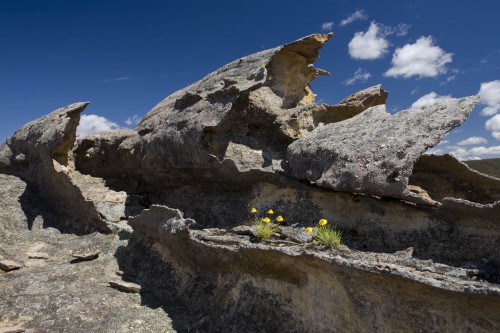 The very yellow Pagoda Daisy (at risk)
©Photo by Ian Brown
(click to enlarge, then click again to enlarge further)
The very yellow Pagoda Daisy (at risk)
©Photo by Ian Brown
(click to enlarge, then click again to enlarge further)
.
Environment groups take action to protect Gardens of Stone
The uniquely scenic and biodiverse Gardens of Stone is under imminent threat due to a consolidation proposal by Coalpac Pty Ltd. If approved, wildlife habitat and natural heritage will be lost forever, water systems will be stressed and there would be direct impacts for local residents. On Saturday 14th May, 2011 environment groups and their supporters will be taking action to help protect this iconic landscape from irredeemable destruction.
“Coalpac Pty Ltd seeks to extend open-cut and highwall mining into a large area of the publicly-owned Ben Bullen State Forest, NSW. The NSW National Parks and Wildlife Service has acknowledged its wish to add this forest to the conservation reserve system as a matter of priority” says Tara Cameron, Vice President of Blue Mountains Conservation Society.
“Many of the highwall scarps will abut strata directly below the ‘pagoda’ rock formations, their features and stability may be threatened by collapse. Environment groups are outraged at this proposal” says Tara Cameron.
“This forest is a publicly-owned area of conservation and recreational importance. The community expects state forests to be protected from destruction in perpetuity. If the NSW Government’s Strategic Regional Landuse Policy is to mean anything for sensitive, natural lands, then the Gardens of Stone must be protected from destructive mining operations, ” says Keith Muir, Director of Colong Foundation for Wilderness.
“This landscape is biodiversity hotspot, characterised by rich old-growth forests. Our iconic Lyrebirds use the sides of pagodas to nest and raise their young. Mining will completely remove their food habitats as well as the habitats of at least 32 threatened native animals” says Belinda Fairbrother, Campaigns Manager for The Wilderness Society NSW.
“Water management and impacts over such a large, exposed open-cut area are of great concern. The large open cut will also create significant dust and air quality issues which will impact directly on local residents” says Caroline Graham, Vice President of Rivers SoS.
“Environment groups are calling on the government to reject this mining proposal and act to protect the region within a State Conservation Area. We are coming together at this event to send a clear message that ‘We say No to open cut mining!’ in this iconic area of our state” says Kevin Evans, EO of National Parks Association of NSW.
“Across NSW, areas of high conservation value and great beauty are under threat from the rapid expansion of the coal and coal seam gas industries. During this time of transitional arrangements on the regulation of coal mining, the State government has an opportunity to deliver on its promise of better protection of water resources and the environment by rejecting further mining at the iconic Gardens of Stone,” says Pepe Clarke, CEO of the Nature Conservation Council of NSW.’
[Source: National Pars Association of NSW, http://www.npansw.org.au/index.php?option=com_content&view=article&id=718:environment-groups-take-action-to-protect-gardens-of-stone&catid=172:2011&Itemid=564]
.
.
‘Part 3A scrapped’
[8 Apr 11, by Tyron Butson, Southern Courier newspaper, http://southern-courier.whereilive.com.au/news/story/part-3a-scrapped/]PREMIER Barry O’Farrell has given increased planning powers back to local councils after scrapping the controversial Part 3A amendment.
He announced the decision to drop Part 3A of the 1979 Environmental Planning and Assessment Act at yesterday’s first State Cabinet meeting.
Local councils will now have final say on many outstanding applications, while others will be referred to the NSW Planning Assessment Commission.
No new Part 3A application for residential, commercial, retail or coastal development will be accepted and the State Government hope to push through legislation that will see the amendment repealed from the Statute books when Parliament resumes.
“This means a return of planning powers to councils and local communities,” Mr O’Farrell said.
“The days of giving the Planning Minister sweeping powers to approve developments at the stroke of a pen with virtually no consultation with local communities are over.
“That extreme power only leads to the sort of suspicion and shady deals we have seen in NSW over the past 16 years.”
The scrapping of Part 3A was a core election promise of the Liberal party, but the government will still have to push legislation through the Upper House.
Mr O’Farrell said he had not attempted to convince opposition members but had directed the Minister for Planning Brad Hazzard to draw up plans.
Until then transitional arrangements will be put into place to deal with more than 500 Part 3A applications already in the system.
About half of the applications will now face the Planning Assessment Commission for assessment, while the rest will either be sent to local councils to vote on or allowed to lapse.
Part 3A was introduced in 2005 and gave planning ministers the ability to overrule local councils and communities on any project the minister deemed to be of state or regional importance.’
.
.
‘Cliffs crumbled due to coal mining, says new report’
(by Ben Cubby, Environment Editor, Sydney Morning Herald, April 27, 2010)
‘DOZENS of cliffs have crumbled or collapsed, Aboriginal rock art has been destroyed and metre-wide cracks opened in the earth as a result of coalmining in the Gardens of Stone wilderness area near Lithgow, an independent report has found.
The damage, inflicted over three decades by five coal mines and continuing today, is caused by subsidence from longwall mining, which now almost surrounds the Gardens of Stone National Park, part of the Greater Blue Mountains World Heritage Site. It is likely to be extended further if a new mine plan is approved by the NSW government.
The report, to be launched today by the former premier Bob Carr, documents wide-scale, unpublicised damage, including the destruction of some of the area’s unique sandstone pagodas and rock arches.
”In its monitoring reports to government, the coal industry regularly understates the damage caused,” said Keith Muir, the executive officer of the Colong Foundation for Wilderness, which produced the report. ”Mine operations do not work to minimise environmental damage and have been largely unresponsive to environmental concerns.”
The study based this conclusion on visual observation in the remote bushland and examination of the the environmental assessments used to justify the expansion of mining. In some cases, the assessments predicted that cliffs could crumble but no remedial action was taken.
The report looks at the six coalmines around the national park: the Angus Place, Springvale and Airly mines operated by Centennial Coal, Baal Bone and Clarence collieries operated by Coalex, and Invincible mine, operated by Coalpac. All the mining companies have met the requirements of their environmental assessment processes and have continued to monitor the impact of subsidence.
Reports produced by consultants employed by the companies showed more than 100 recorded cliff falls in the past three decades. Some led to changes in sites and techniques, but in the majority of cases the warnings were not heeded.
The damage was significantly worse above longwall mines, which cut out long, broad panels of coal, leaving the surface above to crack and subside. The Clarence and Airly mines use the bord and pillar technique, which involves leaving more coal in the ground to support the rock above, resulting in less surface damage.
Aboriginal rock art sites were also photographed with major fractures running through them and, in some cases, entire rock faces destroyed by the effects of subsidence.
”Crevasses, cliff falls and rock fractures are spoiling the sandstone beauty of the Gardens of Stone,” Mr Muir said.
The organisation is calling for a state-sanctioned conservation area that would provide a buffer zone around the park. It would cover part of the Baal Bone mine area, where a further expansion is planned, and the Newnes Plateau, where many swamps have been drained when the rock beneath them cracked open.
”The Department of Environment, Climate Change and Water has been considering proposals for additions to the Gardens of Stone National Park and an evaluation process is under way,” a spokeswoman said.
Read more: http://www.smh.com.au/environment/cliffs-crumbled-due-to-coalmining-says-new-report-20100426-tnbk.html#ixzz1MGS62mRx
.
.
Previously in 2007…
.
.
Further Reading:
.
[1] Previous article on this website: ‘Gardens of Stone at Risk from Coal Mining’, >https://www.habitatadvocate.com.au/?p=4021 [2] Blue Mountains Conservation Society, ^http://www.bluemountains.org.au/gos2.shtml [3] Gardens of Stone National Park, ^http://www.worldheritage.org.au/resources/national-parks/gardens-of-stone-national-park/ [4] The Colong Foundation for Wilderness, ^http://www.colongwilderness.org.au/Gardens_of_Stone/GoS2_home.htm [5] Lithgow Environment Group, Inc. ^http://www.lithgowenvironment.org/mine_watch.html [6] Lithgow Tourism, ^http://www.lithgow-tourism.com/gardenstone.htm [7] Rivers SOS, ^http://riverssos.org.au/2011/04/27/help-us-protect-the-gardens-of-stone/ [8] National Parks Association of NSW, ^http://www.npansw.org.au/index.php?option=com_content&view=article&id=718:environment-groups-take-action-to-protect-gardens-of-stone&catid=172:2011&Itemid=564[9] ‘Cliffs crumbled due to coalmining, says new report’, by Ben Cubby, Sydney Moring Herald, April 27, 2010, ^http://www.smh.com.au/environment/cliffs-crumbled-due-to-coalmining-says-new-report-20100426-tnbk.html
– end of article –
The uniquely scenic and biodiverse Gardens of Stone is under imminent threat due to a consolidation proposal by Coalpac Pty Ltd. If approved, wildlife habitat and natural heritage will be lost forever, water systems will be stressed and there would be direct impacts for local residents. On Saturday 14th May, 2011 environment groups and their supporters will be taking action to help protect this iconic landscape from irredeemable destruction.
“Coalpac Pty Ltd seeks to extend open-cut and highwall mining into a large area of the publicly-owned Ben Bullen State Forest, NSW. The NSW National Parks and Wildlife Service has acknowledged its wish to add this forest to the conservation reserve system as a matter of priority” says Tara Cameron, Vice President of Blue Mountains Conservation Society.
“Many of the highwall scarps will abut strata directly below the ‘pagoda’ rock formations, their features and stability may be threatened by collapse. Environment groups are outraged at this proposal” says Tara Cameron.
“This forest is a publicly-owned area of conservation and recreational importance. The community expects state forests to be protected from destruction in perpetuity. If the NSW Government’s Strategic Regional Landuse Policy is to mean anything for sensitive, natural lands, then the Gardens of Stone must be protected from destructive mining operations, ” says Keith Muir, Director of Colong Foundation for Wilderness.
“This landscape is biodiversity hotspot, characterised by rich old-growth forests. Our iconic Lyrebirds use the sides of pagodas to nest and raise their young. Mining will completely remove their food habitats as well as the habitats of at least 32 threatened native animals” says Belinda Fairbrother, Campaigns Manager for The Wilderness Society NSW.
“Water management and impacts over such a large, exposed open-cut area are of great concern. The large open cut will also create significant dust and air quality issues which will impact directly on local residents” says Caroline Graham, Vice President of Rivers SoS.
“Environment groups are calling on the government to reject this mining proposal and act to protect the region within a State Conservation Area. We are coming together at this event to send a clear message that ‘We say No to open cut mining!’ in this iconic area of our state” says Kevin Evans, EO of National Parks Association of NSW.
“Across NSW, areas of high conservation value and great beauty are under threat from the rapid expansion of the coal and coal seam gas industries. During this time of transitional arrangements on the regulation of coal mining, the State government has an opportunity to deliver on its promise of better protection of water resources and the environment by rejecting further mining at the iconic Gardens of Stone,” says Pepe Clarke, CEO of the Nature Conservation Council of NSW.

